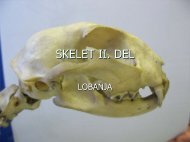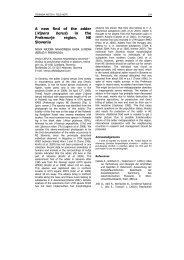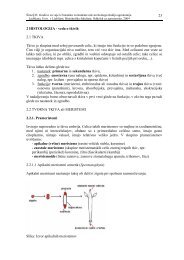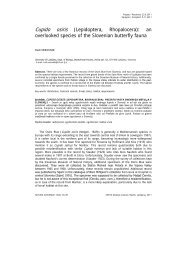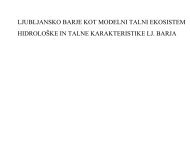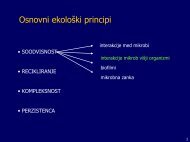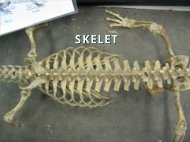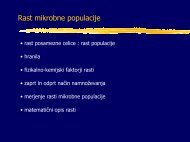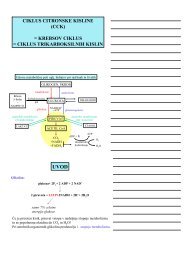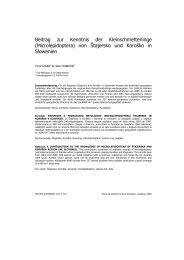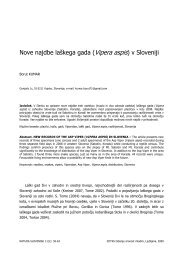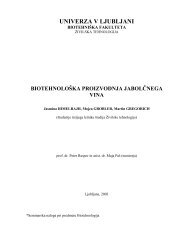Global diversity of leeches (Hirudinea) in ... - Univerza v Ljubljani
Global diversity of leeches (Hirudinea) in ... - Univerza v Ljubljani
Global diversity of leeches (Hirudinea) in ... - Univerza v Ljubljani
You also want an ePaper? Increase the reach of your titles
YUMPU automatically turns print PDFs into web optimized ePapers that Google loves.
Hydrobiologia (2008) 595:129–137<br />
DOI 10.1007/s10750-007-9010-8<br />
FRESHWATER ANIMAL DIVERSITY ASSESSMENT<br />
<strong>Global</strong> <strong>diversity</strong> <strong>of</strong> <strong>leeches</strong> (<strong>Hirud<strong>in</strong>ea</strong>) <strong>in</strong> freshwater<br />
Boris Sket Æ Peter Trontelj<br />
Ó Spr<strong>in</strong>ger Science+Bus<strong>in</strong>ess Media B.V. 2007<br />
Abstract Leeches (<strong>Hirud<strong>in</strong>ea</strong>) constitute a relatively<br />
small monophyletic group <strong>of</strong> highly specialized<br />
annelids, but may play important roles as <strong>in</strong>vertebrate<br />
predators <strong>in</strong> freshwater, while others are <strong>in</strong>famous for<br />
their ectoparasitic bloodsuck<strong>in</strong>g. About 15% <strong>of</strong> the<br />
680 described species are mar<strong>in</strong>e and slightly less<br />
have switched to terrestrial life; the rest are freshwater,<br />
divided among 91 genera. They are globally<br />
distributed on all cont<strong>in</strong>ents except Antarctica,<br />
reach<strong>in</strong>g the highest <strong>diversity</strong> <strong>in</strong> the Holarctic region<br />
with one-half <strong>of</strong> all cont<strong>in</strong>ental species. Known areas<br />
<strong>of</strong> local endemism are the ancient Siberian lake<br />
Bajkal and lake Ohrid (about 10 species each) on the<br />
Balkan Pen<strong>in</strong>sula, which is an endemicity area <strong>in</strong><br />
itself. A small number <strong>of</strong> sanguivorous species<br />
known as ‘‘medic<strong>in</strong>al <strong>leeches</strong>’’ have played an<br />
important role <strong>in</strong> traditional and modern medic<strong>in</strong>e,<br />
most noticeably four Hirudo spp. from the Western<br />
Palearctic.<br />
Keywords <strong>Hirud<strong>in</strong>ea</strong> Leeches Freshwater<br />
Fauna Bio<strong>diversity</strong> Biogeography<br />
Guest editors: E. V. Balian, C. Lévêque, H. Segers &<br />
K. Martens<br />
Freshwater Animal Diversity Assessment<br />
B. Sket (&) P. Trontelj<br />
Oddelek za biologijo, Biotehnisˇka fakulteta, <strong>Univerza</strong> v<br />
<strong>Ljubljani</strong>, Večna pot 111, Ljubljana 1000, Slovenia<br />
e-mail: Boris.Sket@bf.uni-lj.si<br />
Introduction<br />
Leeches (<strong>Hirud<strong>in</strong>ea</strong>) used to be considered as derivatives<br />
<strong>of</strong> oligochaetes, Acanthobdella, with few<br />
chaetae still present, be<strong>in</strong>g the connect<strong>in</strong>g l<strong>in</strong>k. It<br />
is now clear that <strong>Hirud<strong>in</strong>ea</strong> (Achaetobdellae, Euhirud<strong>in</strong>ea,<br />
Hirud<strong>in</strong>ida) constitute a monophylum that<br />
renders the Oligochaeta paraphyletic (Mart<strong>in</strong>, 2001;<br />
Siddall et al., 2001). The Acanthobdellida and the<br />
Branchiobdellida (crustacean epizoans or parasites<br />
traditionally l<strong>in</strong>ked with Oligochaeta) are the two<br />
closest relatives <strong>of</strong> true <strong>leeches</strong>, the latter be<strong>in</strong>g the<br />
more likely sister group, accord<strong>in</strong>g to molecular<br />
phylogenetic <strong>in</strong>vestigations (Siddall et al., 2001).<br />
Leeches are hermaphroditic annelids with<br />
totally reduced both parapodia and chetae, with<br />
unpaired male and female genital open<strong>in</strong>gs <strong>in</strong> the<br />
region <strong>of</strong> the glandulose belt called clitellum, and<br />
with a sucker on both the anterior and posterior<br />
end <strong>of</strong> the body (Fig. 1). Each somite is superficially<br />
divided <strong>in</strong>to usually three to five, but<br />
sometimes more than 10 annuli. The coelomic<br />
cavity is transformed <strong>in</strong>to a contiguous system <strong>of</strong><br />
channels. Many <strong>leeches</strong> are blood-suck<strong>in</strong>g on<br />
vertebrates or <strong>in</strong>vertebrates; the others are ma<strong>in</strong>ly<br />
predators, rarely scavengers. Most <strong>in</strong>habit freshwaters,<br />
but there are mar<strong>in</strong>e and terrestrial species,<br />
too. They reproduce by eggs deposited <strong>in</strong> cocoons<br />
secreted by the clitellum. Their ontogeny is direct,<br />
without larval stages.<br />
123
130 Hydrobiologia (2008) 595:129–137<br />
Fig. 1 Habitus <strong>of</strong> three typical representatives <strong>of</strong> major<br />
hirud<strong>in</strong>ean taxa: (A) Cystobranchus fasciatus, a fish leech<br />
(Piscicolidae), dorsal view; (B) Placobdella costata, a glossiphoniid,<br />
dorsal view; (C) – Barbronia assiuti, an<br />
erpobdelliform, lateral view; (D) Ventral view <strong>of</strong> the clitellum<br />
with genital and accessory open<strong>in</strong>gs; the latter are found only<br />
<strong>in</strong> some species. os––oral sucker, cs––caudal sucker, mgo––<br />
male genital open<strong>in</strong>g; fgo––female genital open<strong>in</strong>g. Orig<strong>in</strong>al<br />
draw<strong>in</strong>gs are a courtesy <strong>of</strong> Hasko Nesemann<br />
Species <strong>diversity</strong><br />
This compilation was greatly facilitated by some<br />
previous local or global monographs, ma<strong>in</strong>ly <strong>in</strong>directly<br />
through Sawyer (1986); beside the latter, such<br />
are by Hard<strong>in</strong>g & Moore (1927), Klemm (1972),<br />
Luk<strong>in</strong> (1976), R<strong>in</strong>guelet (1980), Yang (1996), Nesemann<br />
& Neubert (1999), and a series by Soos (1965–<br />
1969). Numerous primary sources (not listed <strong>in</strong><br />
References) were used to complete the work.<br />
123<br />
L<strong>in</strong>naeus (1789) described 14 species <strong>of</strong> Hirudo,<br />
classified as Vermes Intest<strong>in</strong>a. The classical taxonomy<br />
used to be based on the general shape, color<br />
pattern, position and number <strong>of</strong> eyes, later also on<br />
distance between genital open<strong>in</strong>gs. Moqu<strong>in</strong>-Tandon<br />
(1846) presented anatomical pictures which were<br />
later used extensively; so was also the system <strong>of</strong><br />
annulation with an appropriate cod<strong>in</strong>g, proposed by<br />
Moore (1898). Pawlowski (1948) added the male<br />
atrium shape. However, nobody assessed the variability<br />
level <strong>of</strong> the morphological and anatomical<br />
characters. A study <strong>of</strong> the hirud<strong>in</strong>ean <strong>diversity</strong> <strong>of</strong> the<br />
former Yugoslavia area, notorious for its complex<br />
bio<strong>diversity</strong>, showed that neither the anatomy <strong>of</strong> the<br />
reproductive apparatus nor the annulation is stable<br />
enough to be reliable, as character above the species<br />
level (Sket, 1968). This, and some phylogenetic<br />
uncerta<strong>in</strong>ties, triggered first molecular studies (Trontelj<br />
et al., 1996; Siddall & Burreson, 1998) followed<br />
by many others that are nowadays yield<strong>in</strong>g surpris<strong>in</strong>g<br />
solutions predict<strong>in</strong>g discovery <strong>of</strong> further unexpected<br />
errors <strong>of</strong> the current taxonomy.<br />
However, morphological means allowed us to<br />
describe approximately 680 species till now, some<br />
480 <strong>of</strong> which are freshwater. Bielecki (1997) <strong>in</strong>troduced<br />
new detailed morphological and anatomical<br />
standards <strong>in</strong> the systematics <strong>of</strong> piscicolids (fish<br />
<strong>leeches</strong>) that gave rise to a manifold <strong>in</strong>crease <strong>of</strong><br />
European fish leech species. This, along with a<br />
considerable ‘cryptic’ <strong>diversity</strong> among European<br />
erpobdellids (own studies, unpublished), suggests<br />
that a large number <strong>of</strong> species has still rema<strong>in</strong>ed<br />
unrecognized even with<strong>in</strong> the traditionally beststudied<br />
European hirud<strong>in</strong>ean fauna. The cumulative<br />
plot <strong>of</strong> described species (Fig. 2) shows no sign <strong>of</strong> a<br />
plateau.<br />
These facts also imply that leech taxonomy––at<br />
the species level and higher––is <strong>in</strong> a revolutionary<br />
phase right now. In the present overview (Table 1),<br />
we ma<strong>in</strong>ly follow the system <strong>of</strong> Sawyer (1986) but<br />
we could not ignore some novel f<strong>in</strong>d<strong>in</strong>gs; therefore,<br />
some <strong>of</strong> our solutions are partial and<br />
provisional. Too little care has been taken till<br />
now to represent genera <strong>in</strong> molecular studies by<br />
their type species and species by their topo-type<br />
populations, as these are the only reliable means<br />
for assur<strong>in</strong>g the taxonomical identity <strong>of</strong> objects.<br />
Neither the number <strong>of</strong> families, nor their generic<br />
subdivision, are f<strong>in</strong>al.
Hydrobiologia (2008) 595:129–137 131<br />
Fig. 2 Cumulative number <strong>of</strong> described hirud<strong>in</strong>ean species<br />
per decade. Authors with significant contributions (if 15 or<br />
more species after 1900, 20 or more after 1950) and the phase<br />
<strong>of</strong> their publish<strong>in</strong>g activity are shown<br />
Species <strong>diversity</strong> is relatively evenly distributed<br />
among four major hirud<strong>in</strong>ean clades, the proboscisbear<strong>in</strong>g<br />
Piscicolidae and Glossiphoniidae, the jawed<br />
Hirud<strong>in</strong>iformes, and the predaceous Erpobdelliformes<br />
(see Table 1 for classification and species numbers).<br />
The latter two groups are sisters, <strong>of</strong>ten referred to as<br />
Table 1 Taxonomic overview and <strong>diversity</strong> <strong>of</strong> the <strong>Hirud<strong>in</strong>ea</strong> a<br />
arhynchobdellids for their lack <strong>of</strong> a proboscis. This<br />
leaves the small tropical mar<strong>in</strong>e and freshwater<br />
family Ozobranchidae with an uncerta<strong>in</strong> position<br />
among the paraphyletic group <strong>of</strong> proboscis-bear<strong>in</strong>g<br />
<strong>leeches</strong>, traditionally known as rhynchobdellids.<br />
Piscicolidae are parasites, ma<strong>in</strong>ly on fishes, a large<br />
part <strong>of</strong> them be<strong>in</strong>g the only mar<strong>in</strong>e <strong>leeches</strong>. Bound to<br />
freshwater only, but ecologically very diverse and<br />
globally distributed, are the Glossiphoniidae. They<br />
feed as parasites on vertebrates and <strong>in</strong>vertebrates;<br />
some may be predators if the prey is small enough.<br />
Arhynchobdellids live predom<strong>in</strong>antly <strong>in</strong> freshwaters,<br />
but might also be amphibious or terrestrial. Most<br />
hirud<strong>in</strong>iform species are parasitic on vertebrates;<br />
some are also predators <strong>of</strong> small <strong>in</strong>vertebrates,<br />
occasionally even scavengers. Erpobdelliforms are<br />
exclusively predatory species with an aquatic or<br />
amphibious lifestyle. They swallow their prey as a<br />
whole us<strong>in</strong>g their muscular pharynx. They may occur<br />
<strong>in</strong> high densities and are among the most important<br />
<strong>in</strong>vertebrate predators <strong>in</strong> freshwater communities.<br />
Traditionally a part <strong>of</strong> the <strong>Hirud<strong>in</strong>ea</strong> but now<br />
recognized as a clade <strong>of</strong> their own, the<br />
Major higher taxon Family Freshwater genera Freshwater species Terrestrial (T) or Mar<strong>in</strong>e (M) species<br />
Acanthobdellida Acanthobdellidae 1 2 0<br />
‘‘Rhynchobdellida’’ Glossiphoniidae 25 208 0<br />
Piscicolidae 17 57 100 (M)<br />
Arhynchobdellida<br />
Ozobranchidae 2 7 2 (M)<br />
Erpobdelliformes Americobdellidae 0 0 1 (T)<br />
Erpobdellidae 10 b<br />
69 0<br />
Salifidae 7 28 1 (T)<br />
Hirud<strong>in</strong>iformes Cylicobdellidae 0 0 28 (T)<br />
Semiscolecidae 4 13 0<br />
Haemopidae 3 18 0<br />
Hirud<strong>in</strong>idae c<br />
17 60 4 (T)<br />
Macrobdellidae 5 20 0<br />
Haemadipsidae 0 0 50 (T)<br />
Xerobdellidae 0 0 8 (T)<br />
Total 91 482 102 M<br />
92 T<br />
a The traditional conception <strong>in</strong>clud<strong>in</strong>g acanthobdellids but not branchiobdellids. Not considered are species <strong>in</strong>quirendae (<strong>of</strong> ca 110<br />
species <strong>in</strong>quirendae listed by Soos 1965–1969, only 10 have been classified later and considered here)<br />
b Traditional genera are mostly para- or polyphyletic, a f<strong>in</strong>al subdivision <strong>of</strong> the family is not yet established<br />
c<br />
Includ<strong>in</strong>g Hirud<strong>in</strong>ari<strong>in</strong>ae, Praobdell<strong>in</strong>ae, Richardsonian<strong>in</strong>ae, Ornithobdell<strong>in</strong>ae; provisionally also Limnatis<br />
123
132 Hydrobiologia (2008) 595:129–137<br />
Acanthobdellida are limited to two species at the<br />
boreal fr<strong>in</strong>ge <strong>of</strong> the Holarctic. They parasitize fishes.<br />
The larger, more than 100 spp. strong Branchiobdellida<br />
have been traditionally discussed with<br />
Oligochaeta.<br />
Phylogeny and historical processes<br />
Based on recent molecular phylogenetic hypotheses<br />
(e.g., Apakupakul et al., 1999; Trontelj et al., 1999;<br />
Borda & Siddall, 2004; Utevsky & Trontelj, 2004), it<br />
can be concluded that <strong>leeches</strong> are primarily and<br />
essentially freshwater animals with few switches to<br />
mar<strong>in</strong>e and terrestrial habitats (Fig. 3). Further, their<br />
notorious ectoparasitic bloodsuck<strong>in</strong>g might be a<br />
sophistication <strong>of</strong> a less specialized commensalism or<br />
parasitism <strong>in</strong>herited from ancestors shared with branchiobdellids<br />
and acanthobdellids. It has been<br />
proposed that the first true leech was a proboscisbear<strong>in</strong>g<br />
bloodsucker, and that bloodfeed<strong>in</strong>g facilitated<br />
by jaws as <strong>in</strong> the medic<strong>in</strong>al leech evolved<br />
Fig. 3 Simplified phylogenetic tree <strong>of</strong> ma<strong>in</strong> hirud<strong>in</strong>ean and<br />
sister taxa, the height <strong>of</strong> the triangle reflect<strong>in</strong>g the species<br />
richness <strong>of</strong> each clade. Waves represent the share <strong>of</strong> mar<strong>in</strong>e,<br />
bricks the share <strong>of</strong> terrestrial species, while white areas<br />
correspond to freshwater (and amphibian) species. The share <strong>of</strong><br />
terrestrial erpobdelliforms and mar<strong>in</strong>e ozobranchids (two<br />
species each) is too small to be shown. Dark vertical bars<br />
represent ecto-commensal or parasitic feed<strong>in</strong>g, light bars<br />
predatory behavior. Only relationships that have consistently<br />
received high support <strong>in</strong> all molecular phylogenetic studies are<br />
drawn as resolved<br />
123<br />
<strong>in</strong>dependently, follow<strong>in</strong>g a predatory stage (Trontelj<br />
et al., 1999; Borda & Siddall, 2004).<br />
A second focus <strong>of</strong> current molecular phylogenetic<br />
work is on species-level relationships and alpha<br />
taxonomy. A number <strong>of</strong> studies have <strong>in</strong>dicated that<br />
not only much <strong>of</strong> the traditional low-level taxonomy<br />
is mislead by highly homoplastic characters, but also<br />
a great deal <strong>of</strong> species <strong>diversity</strong> rema<strong>in</strong>ed overlooked<br />
or ignored. Perhaps the most strik<strong>in</strong>g example <strong>of</strong> the<br />
former case is the family Erpobdellidae, <strong>in</strong> which,<br />
after molecular scrut<strong>in</strong>y, virtually all characters used<br />
for subfamilial and generic subdivision (e.g., annulation,<br />
genital anatomy, and color patterns) turned out<br />
to be useless for this purpose (Trontelj & Sket, 2000;<br />
Siddall, 2002). Lack <strong>of</strong> reliable taxonomic characters<br />
is the ma<strong>in</strong> reason for recently discovered cases <strong>of</strong><br />
cryptic <strong>diversity</strong> among erpobdellids. F<strong>in</strong>ally, the<br />
most famous <strong>of</strong> all <strong>leeches</strong>, the European medic<strong>in</strong>al<br />
leech, is represented by at least three species as<br />
demonstrated by phylogenetic analyses <strong>of</strong> nuclear<br />
and mitochondrial DNA sequences (Trontelj &<br />
Utevsky, 2005). Their coloration pattern, <strong>of</strong>ten<br />
rejected as too variable, has ultimately proven to be<br />
a reliable identification feature.<br />
Present distribution and ma<strong>in</strong> areas <strong>of</strong> endemicity<br />
<strong>Global</strong> distribution patterns<br />
Erpobdellidae are evidently limited to the Holarctic.<br />
The only species <strong>in</strong> New Zealand can hardly avoid the<br />
suspicion <strong>of</strong> a taxonomical mistake, while <strong>in</strong> Mexico<br />
the group crosses the border <strong>of</strong> the Neotropical region.<br />
Closely related species are widely distributed across<br />
the Palearctic, as well as between Palearctic and<br />
Nearctic. A particularly high number <strong>of</strong> erpobdellid<br />
species are known from Europe, but the degree <strong>of</strong><br />
knowledge is territorially biased. The Haemopidae<br />
s.str are ma<strong>in</strong>ly Nearctic (Haemopis) and East Palearctic<br />
(Whitmania), with a few species <strong>of</strong> Haemopis<br />
distributed <strong>in</strong> Europe. Generally Holarctic, and<br />
ma<strong>in</strong>ly Western Palearctic, is the whole freshwater<br />
section <strong>of</strong> Piscicolidae. Myzobdella (Neotropical) and<br />
Limnotrachelobdella spp. (E Palearctic) might be<br />
secondary <strong>in</strong>vaders from the sea. Limited to the<br />
Holarctic are also some genera <strong>of</strong> Glosiiphoniidae:<br />
Glossiphonia, Placobdella with the majority <strong>of</strong> species<br />
<strong>in</strong> the Nearctis, and Torix limited to the east <strong>of</strong> the
Hydrobiologia (2008) 595:129–137 133<br />
Fig. 4 Total species and<br />
genus numbers <strong>of</strong> <strong>Hirud<strong>in</strong>ea</strong><br />
per zoogeographic regions<br />
(Species number/Genus<br />
number). PA––Palearctic,<br />
NA––Nearctic, NT––<br />
Neotropical, AT––<br />
Afrotropical, OL––Oriental,<br />
AU––Australasian, PAC––<br />
Pacific Oceanic Islands,<br />
ANT––Antarctic<br />
Eastern Palearctis. In unison, they make the Holarctic<br />
with one-half <strong>of</strong> all cont<strong>in</strong>ental leech species the most<br />
diverse biogeographic region (Fig. 4, Table 2).<br />
In the Neotropical region, the glossiphoniid genus<br />
Haementeria is ma<strong>in</strong>ly tropical and hardly cross<strong>in</strong>g<br />
the northern border <strong>of</strong> the region. Biogeographically<br />
similar, and probably closely related, are the smaller<br />
genera Gloiobdella and Adaetobdella. The genus<br />
Helobdella has, on the other hand, richly speciated<br />
(more than 35 species known) <strong>in</strong> colder (elevated)<br />
regions <strong>of</strong> South America. It developed a couple <strong>of</strong><br />
ecologically very successful species, one <strong>of</strong> which<br />
spread widely <strong>in</strong>to the Holarctic region, possibly as<br />
an accidental passenger on migrat<strong>in</strong>g aquatic birds.<br />
Two additional species succeeded to spread out <strong>of</strong> the<br />
Neotropical region by some human means. A similar<br />
distribution display the hirud<strong>in</strong>iform sister families<br />
Semiscolecidae and Macrobdellidae, the former<br />
be<strong>in</strong>g limited to the Neotropical region, the latter<br />
with at least one genus each <strong>in</strong> the Neotropics and the<br />
Nearctis.<br />
The Oriental region is still relatively rich <strong>in</strong><br />
<strong>leeches</strong> but has virtually no endemic groups. The<br />
region can be characterized by some smaller genera<br />
with predom<strong>in</strong>antly Oriental species and only slight<br />
extrusions <strong>in</strong>to the Eastern Palearctic. Such are<br />
the glossiphoniid Paraclepsis and hirud<strong>in</strong>iform<br />
Myxobdella, Poecilobdella and Hirud<strong>in</strong>aria. Most<br />
Oriental groups are <strong>in</strong> fact Paleotropical, occur<strong>in</strong>g<br />
also <strong>in</strong> the Afrotropical region. Oriental and<br />
Afrotropical is the genus Asiaticobdella; ma<strong>in</strong>ly<br />
Oriental, although generally tropical are freshwater<br />
Ozobranchidae and the rich glossiphoniid genus<br />
Placobdelloides. Limnatis is also present outside<br />
tropics <strong>in</strong> southern parts <strong>of</strong> Europe. The hirud<strong>in</strong>id<br />
Praobdella seems to be purely African.<br />
Somehow <strong>in</strong> the warmer East is also the gravity<br />
po<strong>in</strong>t <strong>of</strong> the family Salifidae; its ma<strong>in</strong> genera, Salifa<br />
and Barbronia, are both present <strong>in</strong> the Oriental region<br />
and <strong>in</strong> the eastern Palearctis, spread<strong>in</strong>g slightly to the<br />
Afrotropical, the Western Palearctic, and even <strong>in</strong>to<br />
the Australian regions. S<strong>in</strong>ce some <strong>of</strong> its species have<br />
clearly demonstrated good spread<strong>in</strong>g abilities, it is<br />
questionable whether such a distribution pattern is<br />
ancient, and if it is natural at all.<br />
The Australasian region, except for the endemic<br />
hirud<strong>in</strong>id subfamily Richardsonian<strong>in</strong>ae (Bassianobdella,<br />
Goddardobdella, Richardsonianus), is <strong>in</strong>habited<br />
by very few freshwater leech species. They belong to<br />
different genera and might be either results <strong>of</strong> late<br />
natural <strong>in</strong>troductions (e.g., by birds) or even <strong>of</strong><br />
taxonomical errors. The most numerously represented<br />
are the snail <strong>leeches</strong> Alboglossiphonia, a globally<br />
distributed genus. Australasia is the doma<strong>in</strong> <strong>of</strong> the<br />
123
134 Hydrobiologia (2008) 595:129–137<br />
Table 2 Number <strong>of</strong> freshwater hirud<strong>in</strong>ean species and genera found <strong>in</strong> major biogeographical regions<br />
terrestrial Haemadipsidae, which might be most<br />
diverse here, while spread<strong>in</strong>g throughout the Oriental<br />
region and even cross<strong>in</strong>g <strong>in</strong>to the SE <strong>of</strong> the Eastern<br />
Palearctic.<br />
PA NA NT AT OL AU World<br />
Number <strong>of</strong> species<br />
Acanthobdellida<br />
Acanthobdellidae<br />
Rhynchobdellida<br />
2 1 0 0 0 0 2<br />
Glossiphoniidae 64 39 69 20 31 13 208<br />
Piscicolidae 40 7 5 2 4 0 57<br />
Ozobranchidae<br />
Arhynchobdellida<br />
1 0 1 1 3 1 7<br />
Americobdellidae 0 0 0 0 0 0 0<br />
Erpobdellidae 46 18 3 0 2 1 69<br />
Salifidae 10 0 0 8 9 4 28<br />
Cylicobdellidae 0 0 0 0 0 0 0<br />
Semiscolecidae 0 1 13 0 0 0 13<br />
Haemopidae 9 7 1 1 1 0 18<br />
Hirud<strong>in</strong>idae 15 0 1 18 14 15 60<br />
Macrobdellidae 0 6 14 0 0 0 20<br />
Haemadipsidae 0 0 0 0 0 0 0<br />
Xerobdellidae 0 0 0 0 0 0 0<br />
Total species<br />
Number <strong>of</strong> genera<br />
Acanthobdellida<br />
187 79 107 50 64 34 482<br />
Acanthobdellidae<br />
Rhynchobdellida<br />
1 1 0 0 0 0 1<br />
Glossiphoniidae 15 11 12 9 10 4 25<br />
Piscicolidae 10 3 2 2 4 0 17<br />
Ozobranchidae<br />
Arhynchobdellida<br />
1 0 1 1 1 1 2<br />
Americobdellidae 0 0 0 0 0 0 0<br />
Erpobdellidae 6 5 3 0 1 1 10<br />
Salifidae 4 0 0 3 3 2 7<br />
Cylicobdellidae 0 0 0 0 0 0 0<br />
Semiscolecidae 0 1 4 0 0 0 4<br />
Haemopidae 2 1 1 1 1 0 3<br />
Hirud<strong>in</strong>idae 6 0 1 6 7 7 17<br />
Macrobdellidae 0 2 3 0 0 0 5<br />
Haemadipsidae 0 0 0 0 0 0 0<br />
Xerobdellidae 0 0 0 0 0 0 0<br />
Total genera 45 24 27 22 27 15 91<br />
PA: Palaearctic Region, NA: Nearctic Region, NT: Neotropical Region, AT: Afrotropical Region, OL: Oriental Region, AU:<br />
Australasian Region<br />
123<br />
The distribution type <strong>of</strong> some phyletic groups is<br />
at present not def<strong>in</strong>able, e.g., the glossiphoniid<br />
Theromyzon has species distributed across all biogeographical<br />
regions except for the Australasian. One
Hydrobiologia (2008) 595:129–137 135<br />
could easily expla<strong>in</strong> this by their relation to waterfowl.<br />
The explanation <strong>of</strong> the even distribution <strong>of</strong><br />
Alboglossiphonia throughout all regions is more<br />
enigmatic. In oceans, piscicolids are present around<br />
all cont<strong>in</strong>ents and at all latitudes. Previous biogeographical<br />
analyses have been published by Soos<br />
(1970), R<strong>in</strong>guelet (1980), and Sawyer (1986).<br />
Endemicity areas<br />
Discovery <strong>of</strong> species flocks and therefore <strong>of</strong> rich<br />
endemic faunas can be predicted for the next future.<br />
They may occur <strong>in</strong> SE Europe (own studies) and <strong>in</strong> the<br />
southern United States (accord<strong>in</strong>g to Govedich et al.,<br />
1999). Most ancient lakes have s<strong>in</strong>gle or no endemic<br />
leech species. Likewise, with only two Caspiobdella<br />
spp., the number <strong>of</strong> endemics <strong>in</strong> the (brackish) Caspian<br />
is surpris<strong>in</strong>gly low, but a number <strong>of</strong> European species<br />
seems to orig<strong>in</strong>ate from Ponto-Caspian waters. Richer is<br />
Lake Bajkal with three piscicolids (Baicalobdella<br />
torquata, Codonobdella truncata, C. zelenskiji) and<br />
some glossiphoniids (Baicaloclepsis ech<strong>in</strong>ulata, B. grubei,<br />
Torix baicalensis and probably some Theromyzon<br />
spp.). The Balkan lake <strong>of</strong> Ohrid harbors the richest<br />
known endemic leech fauna (Sket, 1968, 1989) with<br />
some endemic glossiphoniids (Glossiphonia complanata<br />
maculosa, G. pulchella) and a flock <strong>of</strong> eight<br />
erpobdellid species (‘D<strong>in</strong>a’ ohridana aggregate). The<br />
latter are young species accord<strong>in</strong>g to their mitochondrial<br />
DNA divergence (unpublished results), but remarkably<br />
differentiated <strong>in</strong> their body shapes (Sket, 1989).<br />
Another probable Lake Ohrid endemic is Piscicola<br />
pawlowskii.<br />
Ecological specialists<br />
Some species occur <strong>in</strong> caves (Sket, 1986; unpublished<br />
data). These may be generalists, like Haemopis<br />
sanguisuga, or troglobionts, like H. caeca from<br />
Dobrogea <strong>in</strong> Romania. Particularly rich <strong>in</strong> troglobionts<br />
is the family Erpobdellidae. Some described or<br />
undescribed cave species are present <strong>in</strong> southern<br />
Europe (N Italy–Balkans–Turkey–Caucasus), their<br />
derivative is also the extraord<strong>in</strong>arily transformed<br />
Croatobranchus mestrovi form deep caves <strong>in</strong> the<br />
Croatian D<strong>in</strong>aric mounta<strong>in</strong>s. Some undescribed species,<br />
probably erpobdellids, occur <strong>in</strong> caves <strong>of</strong> Ch<strong>in</strong>a<br />
and the US.<br />
Another habitat less frequently <strong>in</strong>habited by<br />
<strong>leeches</strong> are brackish waters, like lakes and lagoons<br />
along the SE Indian coast (lake Chilka) with<br />
Pterobdella amara, Aestabdella caeca, Calliobdella<br />
olivacea. Both Caspian piscicolids and the Ponto-<br />
Caspian Archaeobdella esmonti can be attributed to<br />
this group.<br />
Among terrestrial specialists the giant Chilean<br />
Americobdella valdiviana, represent<strong>in</strong>g its own family,<br />
is one <strong>of</strong> the largest <strong>leeches</strong> (reportedly<br />
measur<strong>in</strong>g more than 20 cm, along with two other<br />
giants, the Amazonian freshwater species Haementeria<br />
ghiliani and the Antarctic mar<strong>in</strong>e Megaliobdella<br />
szidati). Ornithobdell<strong>in</strong>ae, a couple <strong>of</strong> terrestrial<br />
hirud<strong>in</strong>id species, are feed<strong>in</strong>g on sea-birds and can<br />
be found <strong>in</strong> their colonies <strong>in</strong> Australia and New<br />
Zealand. In the Xerobdellidae, Xerobdella spp. are<br />
terrestrial predators <strong>in</strong> temperate to alp<strong>in</strong>e climates <strong>of</strong><br />
Europe, whereas the neotropical Mesobdella and<br />
Diestecostoma spp. are reported as sanguivorous.<br />
Entirely terrestrial are also the haematophagous<br />
Haemadipsidae and predatory Cylicobdellidae.<br />
Human related issues<br />
Leeches have been <strong>in</strong>timately connected to humans<br />
throughout nearly 2000 years <strong>of</strong> documented history<br />
<strong>of</strong> Western medic<strong>in</strong>e. While <strong>in</strong> ancient times the<br />
haematophagous medic<strong>in</strong>al leech (Hirudo medic<strong>in</strong>alis)<br />
was considered as panacea, nowadays ma<strong>in</strong>ly<br />
its bio-active anticoagulant and anti-<strong>in</strong>flammatory<br />
substances are attract<strong>in</strong>g medical and pharmaceutical<br />
attention (Sohn et al., 2001; Whitaker et al.,<br />
2004). Moreover, the direct therapeutic application<br />
<strong>of</strong> <strong>leeches</strong> is experienc<strong>in</strong>g a renaissance, albeit for<br />
different purposes, e.g., to restore blood circulation<br />
after reconstructive surgery or, recently, to treat<br />
osteoarthritis (Pilcher, 2004). Although the <strong>leeches</strong><br />
are now commercially bred <strong>in</strong> leech farms, the<br />
annual consumption will probably never approach the<br />
n<strong>in</strong>eteenth century numbers when up to 100 million<br />
<strong>leeches</strong> per year were imported to France alone.<br />
It has only recently become clear that most<br />
commercially used <strong>leeches</strong> are not the species<br />
<strong>of</strong>ficially declared (H. medic<strong>in</strong>alis), but rather its<br />
congener H. verbana or sometimes H. orientalis.<br />
Other species, ma<strong>in</strong>ly <strong>of</strong> the SE Asian genus<br />
Hirud<strong>in</strong>aria have been exploited medically and are<br />
123
136 Hydrobiologia (2008) 595:129–137<br />
sometimes even <strong>of</strong>fered for sale as genu<strong>in</strong>e medic<strong>in</strong>al<br />
<strong>leeches</strong>. Even some rhynchobdellids (Haementeria<br />
<strong>of</strong>fic<strong>in</strong>alis <strong>in</strong> Mexico, Placobdella costata <strong>in</strong> Krym)<br />
have been <strong>in</strong> medical use.<br />
The ‘‘medic<strong>in</strong>al leech’’ is protected and/or listed as<br />
endangered species <strong>in</strong> many European countries. It is<br />
not clear to what extent the alleged unfavorable<br />
conservation status is a consequence <strong>of</strong> past overharvest<strong>in</strong>g<br />
and how much <strong>of</strong> it can be contributed to<br />
more recent habitat destruction. Moreover, as long as<br />
the new taxonomic knowledge is not taken <strong>in</strong>to<br />
account, we will not even know which species we are<br />
struggl<strong>in</strong>g to preserve.<br />
Through centuries <strong>of</strong> exploitation and translocation<br />
the natural distribution <strong>of</strong> all Hirudo spp. was probably<br />
substantially affected by humans. More conspicuous,<br />
however, are transcont<strong>in</strong>ental <strong>in</strong>troductions, like the one<br />
<strong>of</strong> SE Asian Hirud<strong>in</strong>aria manillensis to the West Indies<br />
(Kutschera & Roth, 2006), probably also as a consequence<br />
<strong>of</strong> transport for medical purposes. Accidental<br />
transfers <strong>of</strong> <strong>leeches</strong> have resulted <strong>in</strong> several successful<br />
<strong>in</strong>vasions <strong>of</strong> new ranges, most noticeably by the<br />
mislead<strong>in</strong>gly named Neotropic glossiphoniid Helobdella<br />
europaea to Europe and Australia (e.g., Kutschera<br />
2004), or the salifid Barbronia weberi from Asia to<br />
Europe and Australia. Other non-native Helobdella spp.<br />
have been reported from Europe, and the Australian<br />
Barbronia arcana from Mexico (Oceguera-Figueroa<br />
et al., 2005). Although B. weberi has been characterized<br />
as <strong>in</strong>vasive (Govedich et al., 2003), the<br />
<strong>in</strong>vasiveness <strong>of</strong> most non-native leech species does<br />
not approach the aggressive nature <strong>of</strong> some <strong>in</strong>vasive<br />
crayfishes and fishes.<br />
Acknowledgments We thank Hasko Nesemann for k<strong>in</strong>dly<br />
provid<strong>in</strong>g his draw<strong>in</strong>gs, and Gregor Bračko for his help with<br />
copy<strong>in</strong>g out some literature data. This work was <strong>in</strong> part<br />
supported by the Slovenian Research Agency.<br />
References<br />
Apakupakul, K., M. E. Siddall & E. M. Burreson, 1999. Higher<br />
level relationships <strong>of</strong> <strong>leeches</strong> (Annelida: Clitellata: Euhirud<strong>in</strong>ea)<br />
based on morphology and gene sequences.<br />
Molecular Phylogenetics and Evolution 12: 350–359.<br />
Bielecki, A., 1997. Fish <strong>leeches</strong> <strong>of</strong> Poland <strong>in</strong> relation to the<br />
Palearctic piscicol<strong>in</strong>es (<strong>Hirud<strong>in</strong>ea</strong>: Piscicolidae: Piscicol<strong>in</strong>ae).<br />
Genus 8: 223–375.<br />
Borda, E. & M. E. Siddall, 2004. Arhynchobdellida (Annelida:<br />
Oligochaeta: Hirud<strong>in</strong>ida): phylogenetic relationships and<br />
123<br />
evolution. Molecular Phylogenetics and Evolution 30:<br />
213–225.<br />
Govedich, F. R., B. A. Ba<strong>in</strong>, M. Burd & R. W. Davies, 2003.<br />
Reproductive biology <strong>of</strong> the <strong>in</strong>vasive Asian freshwater<br />
leech Barbronia weberi (Blanchard, 1897). Hydrobiologia<br />
510: 125–129.<br />
Govedich, F. R., D. W. Bl<strong>in</strong>n, R. H. Hevly & P. S. Keim, 1999.<br />
Cryptic radiation <strong>in</strong> erpobdellid <strong>leeches</strong> <strong>in</strong> xeric landscapes:<br />
a molecular analysis <strong>of</strong> population differentiation.<br />
Canadian Journal <strong>of</strong> Zoology 77: 52–57.<br />
Hard<strong>in</strong>g W. A. & J. P. Moore, 1927. <strong>Hirud<strong>in</strong>ea</strong>. In Shipley, E.<br />
(ed.), The Fauna <strong>of</strong> British India, <strong>in</strong>clud<strong>in</strong>g Ceylon and<br />
Burma. London.<br />
Klemm, D. J., 1972. Freshwater <strong>leeches</strong> (Annelida: <strong>Hirud<strong>in</strong>ea</strong>)<br />
<strong>of</strong> North America. Biota <strong>of</strong> freshwater ecosystems identification<br />
manual no. 8. Water Pollution Control Research<br />
Series. U.S. Environmental Protection Agency, Wash<strong>in</strong>gton,<br />
D.C.<br />
Kutschera, U., 2004. The freshwater leech Helobdella europaea<br />
(<strong>Hirud<strong>in</strong>ea</strong>: Glossiphoniidae): an <strong>in</strong>vasive species<br />
from South America? Lauterbornia 52: 153–162.<br />
Kutschera, U. & M. Roth, 2006. Notes on the ecology <strong>of</strong> the<br />
Asian medic<strong>in</strong>al leech Hirud<strong>in</strong>aria manillensis (<strong>Hirud<strong>in</strong>ea</strong>:<br />
Hirud<strong>in</strong>idae). Lauterbornia 56: 9–13.<br />
L<strong>in</strong>naeus, C., 1789. Systema Naturae. Vermes.<br />
Luk<strong>in</strong>, E. I., 1976. Pijavki. Tom I. Pijavki presnyh i solonovatyh<br />
vodoemov, Izdatel’stvo ‘‘Nauka’’, Len<strong>in</strong>grad.<br />
Mart<strong>in</strong>, P., 2001. On the orig<strong>in</strong> <strong>of</strong> the <strong>Hirud<strong>in</strong>ea</strong> and the demise <strong>of</strong><br />
the Oligochaeta. Proceed<strong>in</strong>gs <strong>of</strong> the Royal Society <strong>of</strong> London<br />
Series B––Biological Sciences 268: 1089–1098.<br />
Moore, J. P., 1898. The <strong>leeches</strong> <strong>of</strong> the U. S. National Museum.<br />
Proceed<strong>in</strong>gs US National Museum 21(1160): 543–563.<br />
Moqu<strong>in</strong>-Tandon, A., 1846. Monographie de la famille des<br />
Hirud<strong>in</strong>ees. Paris.<br />
Nesemann, H. & E. Neubert, 1999. Annelida: Clitellata:<br />
Branchiobdellida, Acanthobdellea, <strong>Hirud<strong>in</strong>ea</strong>. In: Süßwasserfauna<br />
von Mitteleuropa, 6/2. Spektrum<br />
Akademischer Verlag, Heidelberg, Berl<strong>in</strong>.<br />
Oceguera-Figueroa, A., V. León-Règagnon & M. E. Siddall,<br />
2005. Phylogeny and revision <strong>of</strong> the Erpobdelliformes<br />
(Annelida, Arhynchobdellida) from Mexico based on<br />
nuclear and mitochondrial gene sequences. Revista Mexicana<br />
de Biodiversidad 76: 191–198.<br />
Pawlowski, L. K., 1948. Contributions á la systématique des<br />
sangsues dú genre Erpobdella de Bla<strong>in</strong>ville. Acta zoologica<br />
et oecologica Universitatis Lodziensis, sect. III 8:<br />
1–55.<br />
Pilcher, H., 2004. Medic<strong>in</strong>al <strong>leeches</strong>: stuck on you. Nature 432:<br />
10–11.<br />
R<strong>in</strong>guelet, R. A., 1980. Biogeografia de los hirud<strong>in</strong>eos de<br />
America del Sur y de Mesoamerica. Obra del Centenario<br />
del Museo de La Plata 6: 1–27.<br />
Sawyer, R. T., 1986. Leech biology and behaviour. Clarendon<br />
Press, Oxford.<br />
Siddall, M. E. & E. M. Burreson, 1998. Phylogeny <strong>of</strong> <strong>leeches</strong><br />
(<strong>Hirud<strong>in</strong>ea</strong>) based on mitochondrial cytochrome c oxidase<br />
subunit I. Molecular Phylogenetics and Evolution 9:<br />
156–162.<br />
Siddall, M. E., 2002. Phylogeny <strong>of</strong> the leech family Erpobdellidae<br />
(<strong>Hirud<strong>in</strong>ea</strong>: Oligochaeta). Inveretbrate Systematics<br />
16: 1–6.
Hydrobiologia (2008) 595:129–137 137<br />
Siddall, M. E., K. Apakupakul, E. M. Burreson, K. A. Coates,<br />
C. Erséus, S. R. Gelder, M. Källersjö & H. Trapido-Rosenthal,<br />
2001. Validat<strong>in</strong>g Livanow: molecular data agree<br />
that <strong>leeches</strong>, Branchiobdellidans and Acanthobdella<br />
peled<strong>in</strong>a form a monophyletic group <strong>of</strong> oligochaetes.<br />
Molecular Phylogenetics and Evolution 21: 346–351.<br />
Sket, B., 1968. K poznavanju faune pijavk (<strong>Hirud<strong>in</strong>ea</strong>) v Jugoslaviji<br />
(Zur Kenntnis der Egel–Fauna Jugoslawiens).<br />
Razprave SAZU, Cl. IV., 11(4): 127–197.<br />
Sket B., 1986. <strong>Hirud<strong>in</strong>ea</strong>. In Botosaneanu, L. (ed.), Styg<strong>of</strong>auna<br />
Mundi, pp. 250–253.<br />
Sket, B., 1989. Intralacustr<strong>in</strong>e speciation <strong>in</strong> the genus D<strong>in</strong>a<br />
(<strong>Hirud<strong>in</strong>ea</strong>, Erpobdellidae) <strong>in</strong> Lake Ohrid (Yugoslavia).<br />
Hydrobiologia 182: 49–58.<br />
Sohn, J. H., H. A. Kang, K. J. Rao, C. H. Kim, E. S. Choi, B. H.<br />
Chung & S. K. Rhee, 2001. Current status <strong>of</strong> the anticoagulant<br />
hirud<strong>in</strong>: its biotechnological production and<br />
cl<strong>in</strong>ical practice. Applied Microbiology and Biotechnology.<br />
57: 606–613.<br />
Soós, Á., 1965. Identification key to the leech (Hirud<strong>in</strong>oidea)<br />
genera <strong>of</strong> the world, with a catalogue <strong>of</strong> the species. I.<br />
Family: Piscicolidae. Acta zoologica Academiae scientiarum<br />
Hungaricae 11: 417–463.<br />
Soós, Á., 1969. Identification key to the leech (Hirud<strong>in</strong>oidea)<br />
genera <strong>of</strong> the world, with a catalogue <strong>of</strong> the species. VI.<br />
Family: Glossiphoniidae. Acta zoologica Academiae<br />
scientiarum Hungaricae 15: 397–454.<br />
Soós, Á., 1970. A zoogeographical sketch <strong>of</strong> the fresh-water<br />
and terrestrial <strong>leeches</strong> (Hirud<strong>in</strong>oidea). Opuscula zoologica<br />
Budapest 10(2): 313–324.<br />
Trontelj, P., B. Sket, P. Dovč & G. Ste<strong>in</strong>brueck, 1996. Phylogenetic<br />
relationship <strong>in</strong> European erpobdellid <strong>leeches</strong><br />
(<strong>Hirud<strong>in</strong>ea</strong>: Erpobdellidae) <strong>in</strong>ferred from restriction site<br />
data <strong>of</strong> the 18S ribosomal gene and ITS2 region. Journal<br />
<strong>of</strong> Zoological Systematics and Evolutionary Research 34:<br />
85–93.<br />
Trontelj, P., B. Sket & G. Ste<strong>in</strong>brück, 1999. Molecular phylogeny<br />
<strong>of</strong> <strong>leeches</strong>: congruence <strong>of</strong> nuclear and<br />
mitochondrial rDNA data sets and the orig<strong>in</strong> <strong>of</strong> bloodsuck<strong>in</strong>g.<br />
Journal <strong>of</strong> Zoological Systematics and<br />
Evolutionary Research 37: 141–147.<br />
Trontelj, P. & B. Sket, 2000. Molecular re-assessment <strong>of</strong> some<br />
phylogenetic, taxonomic and biogeographic relationships<br />
between the leech genera D<strong>in</strong>a and Trocheta (<strong>Hirud<strong>in</strong>ea</strong>:<br />
Erpobdellidae). Hydrobiologia 438: 227–235.<br />
Trontelj, P. & S. Y. Utevsky, 2005 Celebrity with a neglected<br />
taxonomy: molecular systematics <strong>of</strong> the medic<strong>in</strong>al leech<br />
(genus Hirudo). Molecular Phylogenetics and Evolution<br />
34: 616–624.<br />
Utevsky, S. & P. Trontelj, 2004. Phylogenetic relationships <strong>of</strong><br />
fish <strong>leeches</strong> (<strong>Hirud<strong>in</strong>ea</strong>, Piscicolidae) based on mitochondrial<br />
DNA sequences and morphological data.<br />
Zoologica Scripta 33: 375–385.<br />
Whitaker, I. S., J. Rao, D. Izadi & P. E. Butler, 2004. Hirudo<br />
medic<strong>in</strong>alis: ancient orig<strong>in</strong>s <strong>of</strong>, and trends <strong>in</strong> the use <strong>of</strong><br />
medic<strong>in</strong>al <strong>leeches</strong> throughout history. British Journal <strong>of</strong><br />
Oral & Maxill<strong>of</strong>acial Surgery 42: 133–137.<br />
Yang, T., 1996. Annelida <strong>Hirud<strong>in</strong>ea</strong>. In Fauna S<strong>in</strong>ica. Science<br />
Press, Beij<strong>in</strong>g.<br />
123



